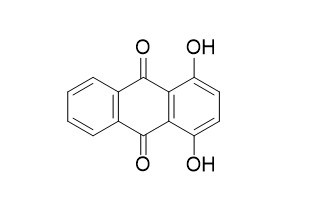Quinizarin
Quinizarin exerts antiproliferative and antimetastatic activity on murine B16-F10 melanoma cells. It possesses significant antineoplastic properties, probably exerts through the induction of intracellular transglutaminase activity. Quinizarin exhibits a strong inhibition of Clostridium perfringens and moderate inhibition of Staphylococcus aureus without any adverse effects on the growth of Bifidobacterium adolescentis, B. bifidum, B. longum, and Lactobacillus casei.
Inquire / Order:
manager@chemfaces.com
Technical Inquiries:
service@chemfaces.com
Tel:
+86-27-84237783
Fax:
+86-27-84254680
Address:
1 Building, No. 83, CheCheng Rd., Wuhan Economic and Technological Development Zone, Wuhan, Hubei 430056, PRC
Providing storage is as stated on the product vial and the vial is kept tightly sealed, the product can be stored for up to
24 months(2-8C).
Wherever possible, you should prepare and use solutions on the same day. However, if you need to make up stock solutions in advance, we recommend that you store the solution as aliquots in tightly sealed vials at -20C. Generally, these will be useable for up to two weeks. Before use, and prior to opening the vial we recommend that you allow your product to equilibrate to room temperature for at least 1 hour.
Need more advice on solubility, usage and handling? Please email to: service@chemfaces.com
The packaging of the product may have turned upside down during transportation, resulting in the natural compounds adhering to the neck or cap of the vial. take the vial out of its packaging and gently shake to let the compounds fall to the bottom of the vial. for liquid products, centrifuge at 200-500 RPM to gather the liquid at the bottom of the vial. try to avoid loss or contamination during handling.
FEMS Microbiol Lett.2017, 364(11)
Nutrients.2018, 11(1):E17
Plant J.2017, 90(3):535-546
Research Square2022, rs.3.rs-1948239
Anal Bioanal Chem.2018, 410(5):1561-1569
Food Chem X.2024, 24:101989.
Cancer Manag Res.2019, 11:483-500
New Zealand J. Forestry Sci.2014, 44:17
Applied Biological Chemistry2023, 66(58):112.
Mol Med Rep.2022, 26(4):299.
Related and Featured Products
Anticancer research, 2010, 30(2):445-9.
Anthraquinones danthron and quinizarin exert antiproliferative and antimetastatic activity on murine B16-F10 melanoma cells.[Reference:
WebLink]
The anticancer potential of anthraquinones danthron and Quinizarin on highly metastatic B16-F10 melanoma murine cells was investigated.
METHODS AND RESULTS:
Several parameters related to cell proliferation and differentiation, i.e. cell number, intracellular content of polyamines, transglutaminase (EC 2.3.2.13) activity and melanin synthesis were evaluated. Tumor cell growth was strongly reduced after treatment with danthron and Quinizarin, as well as polyamine intracellular levels. Moreover, the induction of differentiation in treated cells was demonstrated by the increase of transglutaminase activity. In vitro analysis of adhesion, wound healing migration and invasion showed a remarkable antimetastatic activity of the anthraquinones.
CONCLUSIONS:
The overall results suggest that danthron and Quinizarin possess significant antineoplastic properties, probably exerted through the induction of intracellular transglutaminase activity.
Journal of Microbiology & Biotechnology, 2003, 13(4):529-536.
Inhibitory effects of quinizarin isolated from Cassia tora seeds against human intestinal bacteria and Aflatoxin B-1 biotransformation[Reference:
WebLink]
The growth-inhibitory activity of Cassia tora seed-derived materials against seven intestinal bacteria was examined in vitro, and compared with that of anthraquinone, anthraflavine, anthrarufin, and 1-hydroxyanthraquinone.
METHODS AND RESULTS:
The active constituent of C. tora seeds was characterized as Quinizarin, using various spectroscopic analyses. The growth responses varied depending on the compound, dose, and bacterial strain tested. At 1 mg/disk, Quinizarin exhibited a strong inhibition of Clostridium perfringens and moderate inhibition of Staphylococcus aureus without any adverse effects on the growth of Bifidobacterium adolescentis, B. bifidum, B. longum, and Lactobacillus casei. Furthermore, the isolate at 0.1 mg/disk showed moderate and no activity against C. perfringens and S. aureus. The structure-activity relationship revealed that anthrarufin, anthraflavine, and Quinizarin moderately inhibited the growth of S. aureus. However, anthraquinone and 1-hydroxyanthraquinone did not inhibit the human intestinal bacteria tested. As for the morphological effect of 1 mg/disk Quinizarin, most strains of C. perfringens were damaged and disappeared, indicating that the strong activity of Quinizarin was morphologically exhibited against C. perfringens. The inhibitory effect on aflatoxin B1 biotransformation by anthraquinones revealed that anthrarufin (IC50, 11.49 μM), anthraflavine (IC50, 26.94 μM), and Quinizarin (IC50, 4.12 μM) were potent inhibitors of aflatoxin B1-8,9-epoxide formation. However, anthraquinone and 1-hydroxyanthraquinone did not inhibit the mouse liver microsomal sample to convert aflatoxin B1 to aflatoxin B1-8,9-epoxide.
CONCLUSIONS:
These results indicate that the two hydroxyl groups on A ring of anthraquinones may be essential for inhibiting the formation of aflatoxin B1-8,9-epoxide. Accordingly, as naturally occurring inhibitory agents, the C. tora seed-derived materials described could be useful as a preventive agent against diseases caused by harmful intestinal bacteria, such as clostridia, and as an inhibitory agent for the mouse liver microsomal conversion of aflatoxin B1 to aflatoxin B1-8,9-epoxide.
Inorganica chimica acta, 1982, 67(1):13-18.
Metal ion binding to daunorubicin and quinizarin.[Reference:
WebLink]
The anthracycline containing antibiotic daunorubicin binds metal ions with stabilities similar to those of Quinizarin (1,4-dihydroxyanthraquinone).
METHODS AND RESULTS:
In both ligands phenolic ionizations occur with pKa values near 10.0 and 13.7 as determined spectrophotometrically. Combined spectrophotometric and potentiometric analysis was used to work out the complete microconstant deprotonation scheme for daunorubicin. In daunorubicin the ammonium group deprotonates with pKa = 8.6 and is not involved directly in metal ion binding. Spectrophotometric analysis were used to calculate stability constants. For metal ion binding to daunorubicin the order of decreasing stability constants (with stability constant logarithm in parentheses) is given by Fe3+(11.0) > Th4+(10.3) > Tb3+(7.2) > Zn2+(4.5) > Mg2+(3.7) > Ca2+(3.3). The identical order and similar constants were found for Quinizarin. For both ligands the stability constant logarithms are approximately half the literature values for tiron.
CONCLUSIONS:
Both Quinizarin and daunorubicin may bind a second metal ion. One phenolic proton is displaced for each metal ion bound. Because it is partially stacked in aqueous solutions, the binding of a second daunorubicin ligand to a metal ion is more favorable than the binding of the first.



